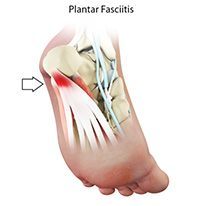Plantar Fasciitis

Plantar fasciitis refers to inflammation of the plantar fascia, a thick band of tissue that lies at the bottom of the foot. It runs from the heel bone to the toe and forms the arch of your foot. Plantar fasciitis is one of the most common causes of heel pain. It is most often seen in middle-aged men and women, but may also occur in those who are constantly on their feet such as soldiers.
Causes
The plantar fascia functions as a shock absorber and supports the arch of your foot. Excessive pressure over the fascia may strain and tear the tissue causing heel pain. Repeated overstretching or overuse causes irritation or inflammation of the fascia.
Other risk factors may include obesity, foot arch problems such as flat feet or high arches, activities such as long-distance running, ballet and dance aerobics, occupations that necessitate walking or standing on hard surfaces for a long period of time, and wearing shoes with poor arch support or thin-soled shoes.
Symptoms
The most common symptom is stabbing pain on the bottom of the foot near the heel. You experience pain when you take your first steps on awakening and it slowly decreases, but may return after standing for a long period of time.
Diagnosis
Your doctor will examine your foot and will check for the signs of flat feet or high arches, tenderness, swelling, redness and stiffness or tightness of your foot arch. Your doctor may suggest an X-ray or MRI scan to rule out other causes of heel pain such as a stress fracture or pinched nerve.
Treatment
Most patients with plantar fasciitis are effectively treated with the following measures:
- Medications: Your doctor may prescribe non-steroidal anti-inflammatory drugs (NSAIDs) to reduce your pain and inflammation. Corticosteroids can be injected directly into the plantar fascia which may offer pain relief and reduce inflammation.
- Rest: Decrease or avoid the activities that worsen the pain.
- Ice: Apply ice pack over the painful area at least twice a day for 10 to 15 minutes, for the first few days.
- Night splints: Use night splints to stretch the plantar fascia and allow it to heal.
- Supportive shoes and orthotics: Your doctor may recommend shoes with good support and cushioning. Custom orthotics (shoe inserts) may also be helpful.
- Physical therapy: Your physical therapist may design an exercise program that focuses on stretching your plantar fascia and Achilles tendon, and strengthening the muscles of the lower leg. In addition to exercises, application of athletic taping to support the bottom of your foot may also help relieve symptoms.
- Extracorporeal shock wave therapy: During this procedure, sound waves are targeted on to the painful area to stimulate the healing process.
- Surgery: Occasionally, surgery to release the tight plantar fascia may be needed.

 Menu
Menu




